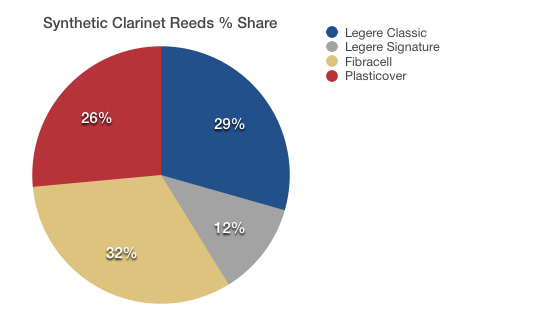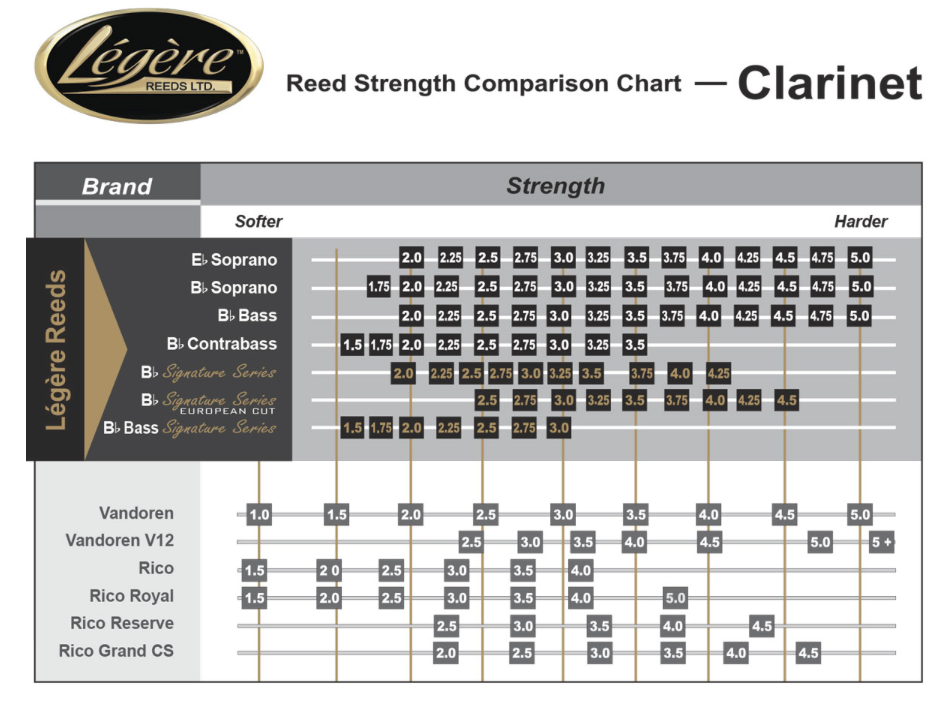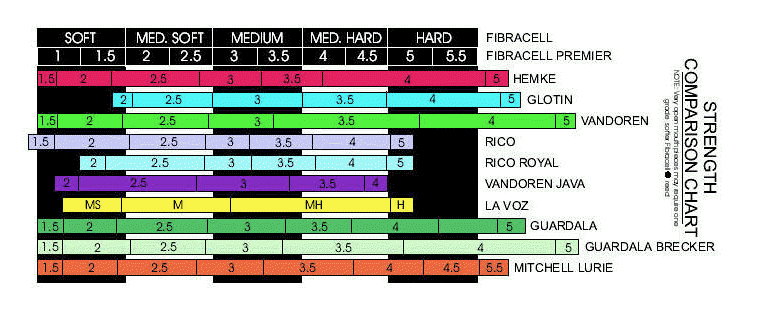‘Reed’ all about it: Part 3 of 3. Synthetic Clarinet Reed Options & ‘Best of the Rest’
5th May 2019Following on from Part 1 (Vandoren & Gonzalez) and Part 2 (D’Addario Woodwinds i.e. Rico, LaVoz etc) we’re going to look at some of todays synthetic options for clarinet players. Plus a special ‘best of the rest’ mention for another brand of cane reed which deserves your attention.
So, lets get to it…synthetic clarinet reeds; for many that still sounds like an alien concept. I will freely admit that previously I’d never found a satisfactory answer in the synthetic world. However, as technology moves on and requirements change I thought it only fair to approach this one with an open mind. After all there are many great pro players now using synthetic reeds, some just in certain scenarios, others more regularly.
I wanted to test the reeds on a range of mouthpieces to really get a good feel for what may work, and what may not. We’ve found in the past that mouthpieces with a shorter lay tend to work better with synthetic reeds as it’s requiring less of the reed to flex and due to the nature of their design and internal structures this can be beneficial. In fact some of the players that are now using them professionally often use quite short and close facings with a synthetic reed set-up.
Over the course of the test I tried the reeds with a Vandoren M30 Lyre (long and relatively close), a Vandoren B45 (medium to long and relatively open), a Otto Link 6* (long and med-open) and a Vandoren 5RV (medium-short and pretty close). Where relevant I will mention the differences between how they performed on certain mouthpieces although I found that the characteristics were pretty similar on all options.
Legere Classic & Legere Signature:
Let’s start with the Legere options as I believe many people have heard the name and arguably Legere have spent the most time and money trying to get some market penetration. By all reports they are doing well in the US at least and Europe is now starting to increase steadily. The packaging and whole story around them is well presented and for many they are the most well know synthetic reed. The people at Legere (based in Ontario, Canada) say:
“Natural cane has a combination of high stiffness and low density that can be difficult to duplicate in a synthetic material. The manufacturers take advantage of the natural variation in cane to produce reeds of different strength.
We have successfully duplicated this property variation in our material, and because we can control the material properties very precisely we are able to deliver reeds of consistent strength – each and every time. Légère reeds are made from polypropylene, which is approved by the FDA for use in direct food contact applications, so our reeds are completely safe to use.”
Well, it’s good to know they are safe to use, something that maybe some people would just assume but when dealing in synthetic materials its worth doing a bit of checking on what is going into it. The question of energy use and the global ‘footprint’ of natural vs synthetic is a topic for another day so for now let’s get into how they play…
The Legere Classic have a thicker tip than the Signature Cut and in fact the whole reed is thicker, this is supposed to give a ‘darker’ sound. I tried a #2.75 strength which matches up similarly to a #3 on the Vandoren V12 (*Strength charts at the bottom of this blog post) which I would say is probably about right. However, it’s very difficult to say because the way they play is very different.
On the M30 Lyre the Legere Classic had relatively clean articulation but I found the sound very buzzy and bright, oh dear, this is what we all feared! But, accepting the fact that arguably a #2.75 was a little soft for quite a close mouthpiece I tried it on the B45 which is more open and thus suited to a slightly softer reed. This is when the interesting phenomenon of ‘Legere-itis‘ kicked in for me (it’s a new term, bear with me)…It’s best described as a strange manifestation of a reed ‘feeling’ too hard (i.e. resistant with a definite lag when trying to articulate quickly) yet the sound it produces is that of a reed which is too soft; i.e. too bright and a little harsh when pushed. Try as I might the same characteristics presented themselves across all 4 mouthpieces, so I moved on…
The Legere Signature reed has a physically thinner profile than the classic, and is thinner at the tip, but is made from a stiffer material. Intrigued as to how this would change the sound and importantly the response I put a #2.75 (supposedly a little softer than the classic #2.75 but a little harder than a Vandoren Blue Box #2.5) on the M30 Lyre. First thing to notice is due to the thinner profile you do have to be sure your ligature is fitting well, the Rovner L5 light I was using was nearly at full screw closure to hold the reed securely.
The Signature had arguably the best clarinet sound in the test, especially in the lower register, there were elements of a ‘real’ reed sound, quite dark and full. However, I found the upper registers were not as good and especially when pushed. There was a bit too much of a brittle feel to the sound. More importantly though I still found the ‘lag’ when trying to articulate quickly and creating much dynamic range (on either Legere) was hard work. There’s a certain beauty to really laying off a cane reed and still getting a ‘core’ to the sound, I couldn’t recreate this on the Legere. I tried it on the rest of the mouthpieces and actually on the B45 it was fairing better. It had that nice real clarinet sound with a nice rich lower register but I still felt it a little bright when pushed and that lag was still there, if a little reduced.
DISCLAIMER: I think it’s important to point out that I am just one person, one opinion etc. I know Legere have some great artists on their books and these players are holding down top spots in big orchestras, I am not. But, nor are 95% of the people reading this blog, so I’m trying to give just an honest opinion on my feelings as an experienced player who’s tried many things in his time at Dawkes.
What would be interesting to know is what reeds and what mouthpiece set-ups their artists are using exactly. Part of me thinks that despite my initial disappointment with the Legere options there could be a combination there that works. There is a new European Signature Cut due soon and it will be interesting to see how that works with the more commonly used mouthpieces in this part of the world. They are clearly well made and I’ve found them a good company to deal with…for now my jury is out, pending further evidence.
Bravo Reeds (the new boys!):
These Bravo reeds arrived with us just after Christmas. They were quietly put onto our system and it was only recently that I had chance to give them a good try. On initial testing a few weeks back I tried the clarinet #2.5 and my colleague Nick tried the same on Alto Sax. In quite a brief after-hours test we determined to come back and give them a proper run out, they had grabbed our interest despite arguably the most average looking box design and basic look of the reed. I was surprised as my initial hopes had not been high.
So, what do the people at Bravo (California) say:
“Our engineered manufacturing process guarantees the consistency every player deserves. We imposed a strict non-toxic manufacturing process in order to protect musicians and workers in our factory, certified by the stringent standards of the European Union.”
Good good, another thing that’s safe to put in my mouth, not much detail on what it is, but as long as its safe. For this test I actually used a #3. I’m going to get straight to it and say these actually felt in many ways like a normal reed, responded like a normal reed and you get 5 in a box that all play the same. Interestingly they’ve not gone down the ‘buy one reed and make it last 3 months’ route and charge the price of a box for a single reed like Legere, Fibracell etc. Rather, you get a box of 5 and to me they all felt pretty consistent, what I can’t tell you yet is how long each will last.
I tried the #3 on all mouthpieces and on the B45 in particular it played really well, it felt similar in strength to a hard Rue L’Epic 2.5 or a slightly soft Vandoren V12 #3. The notes I jotted down at the time of the test were: “YES! Nice. Easy to control, clean sound but with depth and good articulation. Too clean? Depends.” I like to have a cleanliness and centre to my sound, as long as it still has depth and for me the Bravo felt the ‘best in test’ on this point. Especially in the nature of how they responded like a normal reed, also it was possible to get right down to pp and up to ff without too much change in the tonal quality.
INTERLUDE: The Sales Stats:
As before in the other blogs looking at the cane reeds we’ve gone back to our sales records from 1st Oct 2015 to 31st Jan 2016 to look at how the main synthetic clarinet reed sales stack up in comparison to each other. It’s worth noting we are counting 1 x box of Plasticover (5 reeds) as 1 unit. This seems fair bearing in mind Fibracell & Legere would say buying 1 of their reeds is equivalent to a box of ‘normal’ cane reeds. Bravo are not included as they only hit the shop floor end of January.

Factors to consider:
- The length of time people use these reeds for can vary, I’ve heard 2 months to 12 months! Arguably you may get through more than x1 box of Plasticover in the time you could get a Legere to last.
- Stock an all types and strengths is not always as readily available from suppliers as Vandoren or Rico for example. There may have been down times on out of stock lines in this time period.
- Despite my average feelings about the Legere Classic they consistently stand up well in the figures.
Fibracell:
I haven’t yet put into context why someone may consider a synthetic reed and this may be a good time to do it. In my experience I hear the following reasons:
- Looking for greater consistency
- No need to ‘break’ reeds in, ready to blow straight away
- Cheaper in the long run than constantly buying boxes of cane reeds
- Uniform sound, immune to temperature & humidity changes
If one of those reasons is ever that you want to double the volume of your sound I introduce you to Fibracell…It’s the clarinet equivalent of giving yourself of a performance enhancing steroid! Fibracell (USA) say:
“Fibracell material is a sophisticated composite of aerospace materials designed to precisely duplicate the way Nature constructs reed cane. Very stiff but sound absorbing Aramid fibers are suspended in a light weight resin formulation. Fibracell reeds are sold individually and last up to 6 times longer than cane, making them less expensive to use than cane!”
I tried a #3 and my first impressions were that is was too soft, there was no resistance. Sadly we didn’t have a #3.5 or higher in stock at the time of the test. But, it felt extremely lively, articulated very well (no Legere-itis) and it was very consistent in its tone from top to bottom. Whether you like that tone is subjective, I would say if I wanted to get huge projection, maybe in a jazz band, marching band or as some sort of early warning system on the coast I would probably give these a go.
Joking aside, I’d really like to try a harder one to see how that affects it. My feeling is that it won’t add the warmth and solid richness I’d hope for from a Rue L’Epic #3.5 but perhaps it would just start to get more resistant and that may kill the fun. That said even on a 5JB Vandoren (very large tip opening) the #3 felt soft, and I’d usually only use a #2 or #2.5 in other brands on that mouthpiece.
Plasticover:
So, now we’re going into a brave new world…part normal reed, part ‘synthetic’. Or to be more precise this is how D’Addario Woodwinds describe the Plasticover range (you know D’Addario, the people that OWN Rico brand? If not read this blog):
“Plasticover reeds feature the standard Rico cut (the profile used for the vamped portion of the reed) with a plastic coating, which resists moisture and remains stable in varying weather conditions. This coating results in a bright, projecting tone and offers greater durability and lifespan. Plasticover is a favorite among jazz and pop musicians and also works well in outdoor settings.”
As such you won’t be surprised to learn that they play very similarly to the normal Rico type reed but with a little extra brilliance and vibrancy. However I’ve found this is more present in the Plasticover Sax reeds, the added brightness on the clarinet version is minimal for me. These are a good option if you want to retain a more normal cane sound but with some added bite. We’ve also found them good for people who have minor allergies to the cane reeds as they protect the lips a little but without having to get used to how a fully synthetic reed plays.
‘Best of the Rest’ Wood Stone Reeds (non-synthetic):
I mentioned in part 2 of 3 that we’d look at synthetic and the ‘best of the rest’ cane reeds. The main one I’d like to point out to people is definitely these Wood Stone cane reeds. Supplied in a box of 5 they are not cheap, but they have proved to be very popular so far. The consistency is fairly unbeatable, they feature a thick heel and heart with a thin tip, similar to Vandoren Classic Blue Box. The Wood Stone reeds offer a quick response due to the thin tip and a rich and deep sound thanks to the thick heart. French filed, so will suit most Vandoren/Selmer etc mouthpieces. The #2.5 is similar to a V12 #2.5, if anything a tiny bit softer, the #3 jumps up a little and I would say it’s similar in strength to a Rue L’Epic #3.
Hand selected from premium quality french cane the Wood Stone reed is meticulously created to the exacting standards of the Wood Stone specialists in Japan. So far I’ve been getting on very well with the #3’s and have found them to have a nice mix of brightness with body. They are currently my clarinet reed of choice.
This concludes our look at the current state of the Clarinet reed market. If you want to check out the previous blogs see the links below, and don’t forget to contact us if you have any queries regarding reeds that we can help with.
- Part 1 of 3: Vandoren & Gonzalez Clarinet Reeds (click here)
- Part 2 of 3: Rico Group (Rico, Rico Royal, Reserve, Grand Concert etc) (click here)
- See our range of clarinet reeds (click here)
Author: Sam @ Dawkes
Want more content like this? Sign Up to our regular instrument newsletters, choose your instrument and get info on the latest products, video reviews, blogs, offers, workshop tips and more.
Strength Charts:

